Introduction: Postwar USN ASW Policy
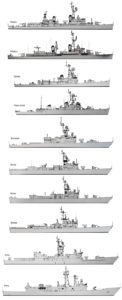 The entire array of destroyers and escort destroyers inherited from WW2 was reclassified “ocean escort” (provided they had the range). This was a definitive ASW-oriented path and either escort and fleet destroyers were converted into ASW specialists, the DER, DET and FRAM in the 1950s-60s. It was also thought to replace the immense fleet of coastal/short range PC/PCE boats with brand new ships, in limited serie but with mass production in mind.
The entire array of destroyers and escort destroyers inherited from WW2 was reclassified “ocean escort” (provided they had the range). This was a definitive ASW-oriented path and either escort and fleet destroyers were converted into ASW specialists, the DER, DET and FRAM in the 1950s-60s. It was also thought to replace the immense fleet of coastal/short range PC/PCE boats with brand new ships, in limited serie but with mass production in mind.
But the problem that soon appeared with the WW2 ASW converted escorts and even the new ones, was speed, starting wth the very fast Soviet Whiskey-class, able to escape most ASW vessels fielded by the USN but fleet destroyers. The admiralty soon evaluated an escort was targeted to be at least capable of 27 knots, and the Dealeys were created with that in mind. But soon the arrival of the November class SNA -capable of 30+ knots- once again changed the requirements, and following classes would try to marry the best ASW array with range and speed, an always difficult combination. However plans for mass-building fast ASW vessels little time after the immense fleet of escort already consented during the war meant the Congress rejected it.
A few of the old Fletchers in the meantime, which had the required speed, were converted as DERs, and the remainder were left in reserve in case of an emergency. In case of war it still was hoped that the congress would approve fast conversions on the same model. The program as later was ditched and focus turned into a new generation of ASW sensors and weaponry. At best the Fletcher DERs seemed a stopgap solution.
Meanwhile the Gearing’s own conversion undergone a program of hunter-killer groups, centered around a carrier. This was done through SOSUS contacts, and the carriers were reconverted Essex class ships. The FRAMs were in effect the first real mass-conversion, updated in detail and in concept, of the previous DERs. Increased ASW systems was done by sacrificing all AAW capability, therefore the ships became inadequate for convoy protection or regular task forces. Although still under the umbrella of “ocean escorts” they were in the 1960s, still very fast and had a longer range that frigates.
Specialized mass-production ships only led to limited series, either the Dealey and Claud Jones, as said above, tailored to be mass-produced in case of war. They had many shortcomings though -particularly in the case of the Claud Jones- and the solution evolved over time up to the more versatile, roomier and faster Knox. The intermediate solution was to use a large array of ASW planes and LAMPS helicopters for SOSUS.
USN cold war ASW weaponry
This evolution mirrored the progresses made in submarine design in this era, and sensors and weapons ranges evolved in concert. To the 1950s sonar range of 1500 yards, weaponry was adapted to an equally short range, 250 to 300 yards for the hedgehogs and 800 for the more sophisticated weapon Alfa, as well as homing ASW torpedoes. The SQS-4 sonar of the 1960s was capable of 5000 to 10,000 yards, and long-range weapnry took the shape of the RAT torpedo (rocket-launched) capable of 5000 yards, while the DASH drone helicopter (one of the first military drone in existence), could bring this to 15,000 yards.
FRAM II ships introduced a variable-depht sonar to track now deep-diving subs and inreased audio quality, and later appeared long-range Mk.37 ASW torpedoes. FRAM-I vessels were upgraded with the SQS-23 sonar (10,000 yds, reliable sphere), and in parallel was developed the familiar ASROC, capable of hitting a target at 20,000 yards. Signal and detection range could be of course further extended by the use of LAMPS-III Helicopters (Seahawk) onboard the larger 1970s frigates. The ships’s size was also function of the size of the sonars. The SQS 4 could fit in ww2 ships, but the SQS-26 needed almost a cruiser-size ship and barely fit into the roomy Knox and Perry.
3 in guns/50
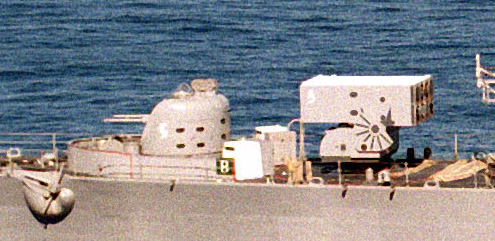
Details of the last Frigate to use the 3 in/50, USS Bronstein, closeup, with the ASROC behind. The Bronstein had a single mount aft.
The venerable 3 in/50 of of the USN was everywhere, from submarines to large and small warhips, as a main close defence weapon, dual purpose although this was only true in WW1 due to the weak speed and altitude of planes. The version that was used, the Mark 22, was developed in 1944. The barrel length was 150.3 inches (382 cm) bore (50 calibres). It fired the 24 lb (11 kg) armor-piercing, AA, VT Frag (Variable Timing Fragmentation), or Illumination 13 lb (5.9 kg). Rate of fire was 20 rounds on average, manual loading.
Range was 14,600 yd (13,400 m) at 43° elevation with a 30,400 ft (9,300 m) AA ceiling.
In the 1960s, the Mark 22 evolved and adopted proximity fuze and fire-control radar. The Twin 3″/50 mount was able to fire 50 rounds per minute and per barrel, and the USN found it more effective than the WW2 classic quad Bofors 40 mm gun, but only against subsonic aircraft.
Some of the FRAM destroyers kept these guns, and aicraft carriers were equipped with twin mounts AA Mk. 33 for most of the cold war. In fact the gun was officialy retired from the USN inventory in 1992.
3 in guns/70

USS Carpenter, DER conversion using the 3 in/70 twin gun
This dual-purpose gun specialized for AA defence was common durong the cold war. Called the 3″/70 Mark 26 gun it was designed to replace both AA systems, the standard-issue WW2 Oerlikon 20 mm cannon and Bofors 40 mm. They were alreadytoo small to kill-stop Japanese kamikaze, and after a long joint study with UK, the design was finalized in 1956. The Mark 26 was a clear improvement over the /50 Marks 33,34. The barrel was increased and range jumped by 5,000 feet (1,500 me) at 5°, and the ammunition would still receive a VT radar proximity fuze. The twin barrel mount became standard, and the sing mount never saw service. It was rated for 90-100 rpm, with a 3,400 fps (1,000 m/s) muzzle velocity and extreme range of 19,500 yards (17,830 m). This model was used on two DER conversions, five DL destroyers (Mitscher), and the command ship USS Northampton.
Weapon ALFA
Developed from the Mousetrap 375mm (14.8″) Bofors, and designed to answer Soviet 250 mm and 300 mm systems, naval multiple rocket launchers, Weapon “Alfa” emerged in the end of World War II, to kill the Type XXI U-boat. Development ended in 1950 with a launcher for a rocket weighing 227 kg (500lb), but of standard 127mm (5″) caliber. Each carried a 113 kg (250lb) warhead. It acted as a superfast depth charge, sinking at 12m/s (40ft/s). The revolving Mark 108 launcher had a range of 360-730m (400-800yd). The sonar allowed to gather data to set the time fuse. The launcher fired one rocket at a time, but could fast-reloading after the rocker was fired, with 22 ready ammunition behind. Therefore practical rate of fire was twelve a minute.
USN Hedgehog ASWRL
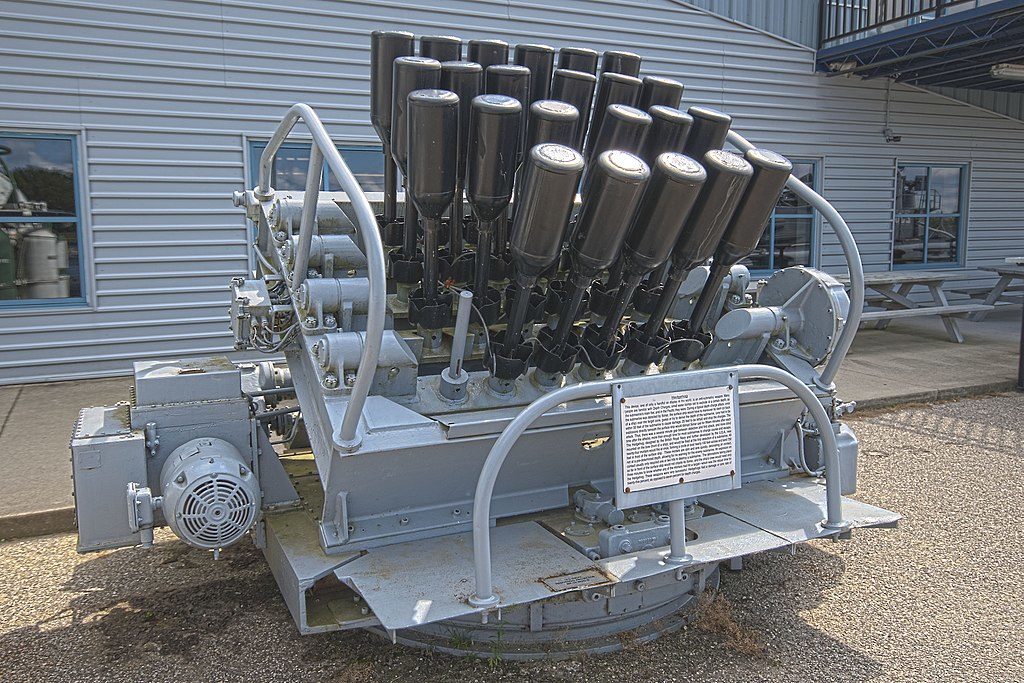
A hedgehog launcher on displayat USS Silversides museum, Muskegon -by Aaron headly- Creative Commons.
The classic WW2 hedgehog developed from british models in 1942-43 was still widely used. They presented tow main advantages: Maintaining the ASDIC contact (and later sonar) longer, having a greater reach both in distance and depth (in speed). They only exploded on contact, therefore athe absence of explosion panache meant a new attack was to be performed.
Compared to a standard depht charge sinking at 2.7-5m/s (8.9-16.5ft/s), the added velocity of the rocket allowed the TNT warhead to reach a crash-diving submarine. They were developed from Mark 10 and 11 models, themselves derived from the British Spigot mortar. Standard-issue in the 1950s and early 1960s these were called “Hedgehog projectors” and can fire 7.2 inches (18.3 cm), 65 lbs. (29.5 kg) projectiles, each carrying a 35 lbs. (15.9 kg) Torpex charge.
Their sinking speed was 22-23.5 fps, and they were fired either in an elliptical pattern 195 feet (59 m) by 168 feet (51 m) at 283 yards (259 m). The Mark 11 fired projectiles in a circular pattern 267 yards (244 m) wide, same range. 24 projectiles were thrown with 0.1-0.2 secs. between pairs and reloading time was 3 minutes. When fired they hit the water 17 sec. after, and up to 34 seconds to reach a 600 feet (183 m) of depth. The last model used by the USN was the Mark 15, mounted on a stabilized platform adapted from a quadruple 40 mm Bofor mount, and which could be fired remotely from the plotting room.
ASWRL “Mousetrap”
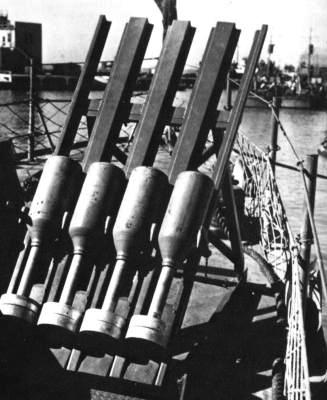 Other Marks appeared afterwards, abandoned, projected or in limited use, until the Mark 20 “mousetrap” system firing four projectiles at once, called the Mousetrap rocket projector with four rails. It used a lighter model than the usual 85 lbs. (39 kg) but was found difficult to handle. The whole system was lighter and smaller and therefore could replace the hedgehog on smaller ASW vessels and patrol crafts. The Mark 22 was an improved model, but it was eventually dropped while the British squid was evaluated. The weapon Alfa took its place and the RAT was also tested on the USS De Haven DD-727. For all purposes the RAT was a missile, not a rocket and an ancestor of ASROC.
Other Marks appeared afterwards, abandoned, projected or in limited use, until the Mark 20 “mousetrap” system firing four projectiles at once, called the Mousetrap rocket projector with four rails. It used a lighter model than the usual 85 lbs. (39 kg) but was found difficult to handle. The whole system was lighter and smaller and therefore could replace the hedgehog on smaller ASW vessels and patrol crafts. The Mark 22 was an improved model, but it was eventually dropped while the British squid was evaluated. The weapon Alfa took its place and the RAT was also tested on the USS De Haven DD-727. For all purposes the RAT was a missile, not a rocket and an ancestor of ASROC.
ASW Grenades
Early depth-charges still in use were 1944-designed Mark 16 models, in service by 1946. They still used set proxmity fuses. Total Weight was 435 lbs. (197 kg), Explosive Charge 295 lbs. (134 kg) of Torpex, and sink rate/Terminal Velocity was about 31 fps (9.4 mps). Maximal setting was 2,500 feet (762 m). These models were thrown in standard racks (stern) or mortars/projectors (side) like for WW2 ships.
ASROC
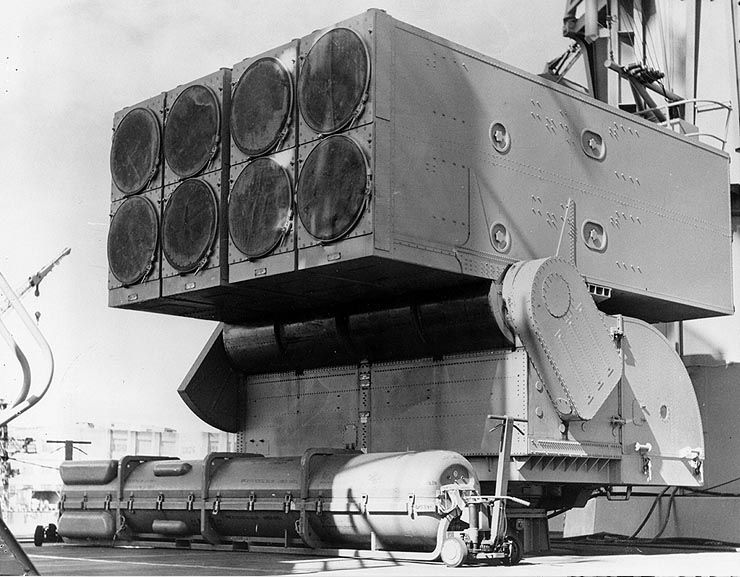
The characteristic RUR-5 “Matchbox” launcher of the 1960s.
Officially called RUR 5, Anti-Submarine ROCket, the famous acronym became the proverbial ASW weapon of choice during the cold war. It was not only used by the USN but a large variery of navies from major nations but France and UK. Although the concept was still inherited from the Hedgehog, rockets were replaced by missiles at the end of the program. It started with the RAT or Rocket Assisted Torpedo program by the Naval Ordnance Test Station at China Lake in the 1950s. The idea was to launch at great distances a torpedo delivered by parachute from the air, giving little notice to the attacked submarines, reached underwater in seconds.
The program ended with a derivative of the RAT-C, which became operational in 1960 on USN destroyer USS Norfolk. The system called for a distinctively orientable MK-112 “Matchbox” launcher, which lasted for 30 years and became a familiar feature of all USN ships of the Frigate size and above; It was replaced in 1990 by vertical launchers RUM-139/VLA. When the position was located, a rocket propelled an offensive payload which could be an acoustic homing torpedo or even a W44 Nuclear Depth Bomb. The Mark 46 torpedo carried a 96.8 pounds (43.9 kg) PBXN-103 HE oayload. The use of a parachute allowed entering water at low speed, with minimum detectable noise.
The W44 lacked precision but of course the blast was a 100% kill even at a distance. Depending on the model, torpedoes were self-guided using an active or passive sonar. The W44 was a 10 kt model, retired in 1989 of all ships when the Nuclear Test Ban Treaty was signed. The Soviet navy also made use of small nuclear depht charges, sometimes dropped by helicopters.
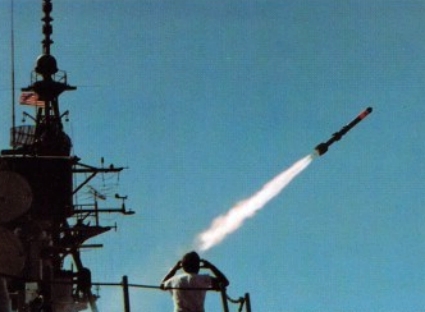
DASH
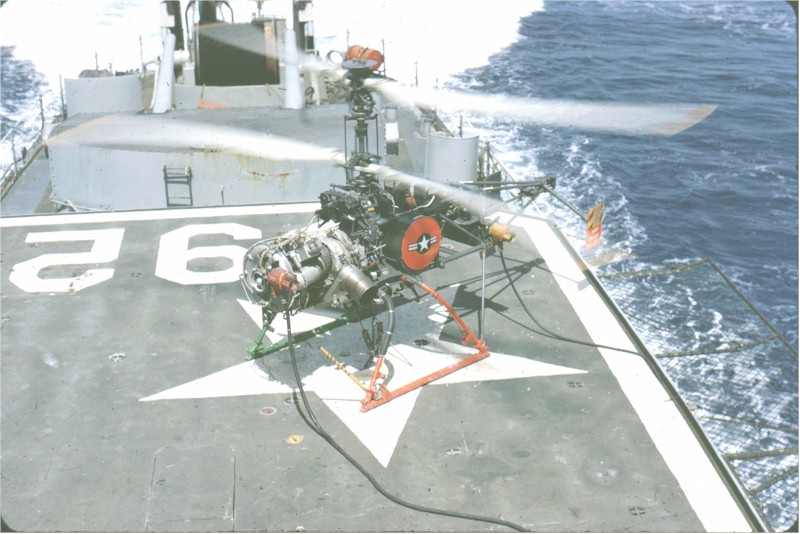
The Gyrodyne QH-50 DASH (Drone Anti-Submarine Helicopter) was one of the first recorded naval drones. By eliminating the human factor, it was possible to design a much smaller craft, available to be used on smaller USN ships, such as frigates and patrol boats. It was not tasked of the same duties as regular helicopters, usually performing SAR missions much often than ASW hunting or communication relay for OTH missile guidance. The system was created to boost ASW capabilities of existing ships -new and converted- at a time the Soviet Navy was building submarines faster than the USN could build ASW frigates.
Tests began in the late 1950s already and the first operational model was introduced in 1962. The intermediate, and most current model Mark II was propelled by a pair of Porsche YO-95-6 engines and carried a single Mk 43 homing torpedo. It used a contrarotary drive to stay compact. The idea came from the attempted USMC scouting RON Rotorcycle. But in the end the DASH was considered expendable and used extensively cheap off-the-shelf industrial electronics with no back-ups and multi-channel analog FM. In action, the attrition rate was enormous, with 80% losses due to system failures and malfunctions. So much so that the whole program was scrapped in 1969, when the USN was focused on Vietnam and ASW was no longer a priority, at least officially.
ASW Torpedo Tubes
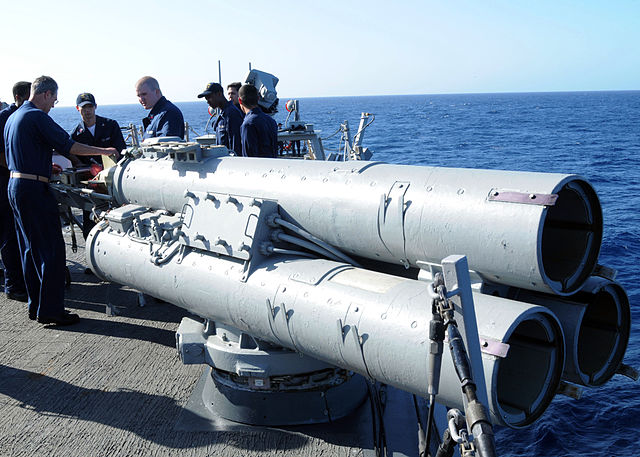
We will focus on the Mk.23 torpedo tube banks, the most common, new generation ASW torpedo tube banks in service, called in naval nomenclature Surface Vessel Torpedo Tubes (Mk 32 SVTT). It was in design, tailored to fire relatively small homing torpedoes, of the 12.75-inch (324 mm) caliber. These torpedoes were modernized in successive lines, the Mark 44, 46, 50 and 54. They were light enough to be manned by the crew without the intervention of a crane or pulleys. This universal standard used by other navies of NATO also allowed the use of Australian MU90 Impact models and British Sting Ray torpedoes.
The 2,230 pounds (1,010 kg) tubes are simple, using compressed air stored in a rear flask, weatherproof, made of fibreglass or fiberglass liner encased in metal ad can store the projectiles for long periods of time, requiring maintenance. One is stacked on top of the two others to gain space. Their compact size allowed them to be place on the ships broadside, alongside existing superstructures without much change. They could be fired manually as a backup but normally remotelly.
The standard was the Mark 44 ASW homing torpedo, the most common NATO model also used and built under licence by Canada, France, Italy, Japan and the United Kingdom. About 10,500 has been made for the U.S. Navy alone, with a production starting in 1957 and spanning until 1967. Designed by Naval Ordnance Test Station Pasadena (GE), it weighted 432 pounds (196 kg) for 8.2 feet (2.5 m)
by 12.75 inches (32.4 cm). Projected at 400 ft/s its payload was a Mk 101 Mod 0, HBX-3 75 pounds (34 kg) torpex charge, explosing on contact. Operating depht was 1,000 yards (910 m), at a speed of 30 knots (56 km/h; 35 mph), thanks to a 30 hp (22 kW) eletric engine and operational range of 3.4 miles (5.5 km). The Helix was a vacuum tube-based guidance system with a range of settings, driving the active sonar. The torpedo searched a target until exhausting its 6-min endurance.
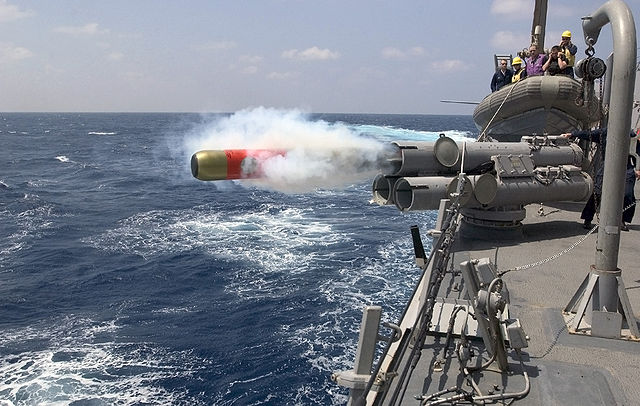
ASW Helicopters
Although a bit off-topic as this chapter is considerable and concened all USN Ships, we will focus there on the only models deployed on the ships large enough to host them: The Knox and Perry class frigates. Two Brooke class ships however has been modified to operate LAMPS-I types. At their introduction in the 1960s, the Knox class were fitted to operate only the unmanned DASH system. But they were refitted later to operate a LAMPS-I, and both sometimes could be swapped due to the generous space of the hangar. The Perry operated LAMPS-I/II models right from the start.
There has been three models of the ASW-specialized helicopters in USN service, called LAMPS (Light Airborne Multi-Purpose System).
LAMPS-I/II were Kaman SH-2F Seasprite, LAMPS-III much larger Sikorsky SH-60B Seahawk.
Frigates, having limited size, operated the Kaman.
![]()
Born in July 1959 (first flight HU2K-1), introduced from 1962, only 184 were made until 1969. It was strickly a USN ship-based utility helicopter made by the small Kaman Aircraft Corporation. Outside the US it was also evaluated by the RCAN and used by the Royal New Zealand Air Force. Outside ASW warfare, it was also used as a Utility transport helicopter and for SAR missions, and very active during the Vietnam war. The last “official” version was the SH-2F propelled by two 1,350 shp (1,007 kW) General Electric T58-GE-8F turboshaft engines, although the company participated in another call to offers with a renewed version called the Kaman SH-2G Super Seasprite, a pure ASW model ftted with two 1,723 shp (1,285 kW) General Electric T700-GE-401 turboshaft engines. It was first tested in 1985, introduced in 1993, and adopted also by the Egyptian, RNZN and Polish Navy.
USN cold war sonars
The first and most common model developed for the USN was a passive hull sonar SQS-4. It was declined into four evolutions (mods), with about the same range of 4500-5000 yards, and a frequency ranging from 8 to 14 Khz. Pulse Lengths and Pulse Powers were 6 ms (50 kW), 30 ms (30 kW), 80 ms (10 kW). Soon after appeared the SQS-7 (12 kHz) with pulse Lengths of 3 ms (50 kW), 10 ms, 30 ms, 60 ms, a Beam width of 20° x 20°, range scales of 2500, 5000 and 10,000 yards, also tested in VDS version.
The SQS-10 was used on the DDE conversions escort destroyers, with a frequency of 20 kHz, pulse Lengths & powers of 6 ms (50 kW), 30 ms (10 kW), 80 ms (3 kW), a beamwidth of 19°, scanning Rate of 150 cps and range scales of 1000, 3000 and 6000 yards.
The last model, installed from 1958 and assimilated to the adoption of ASROC, was SQS-23 nicknamed the “10,000 yards sonar”. It worked with frequencies 4.5 kHZ, 5 kHZ, 5.5 kHZ, pulse Lengths of 5 microseconds, 30 microseconds, 120 microseconds, Beam width of 9.25 x 9.25 deg with vertical variations, coverage of 300 degrees (stern baffles limits), scanning Rate of 150 cps and range scales of 1,000, 2,500, 5,000, 10,000, 20,000 and 40,000 yards.
DER Converted Destroyer Escorts (1950-55)
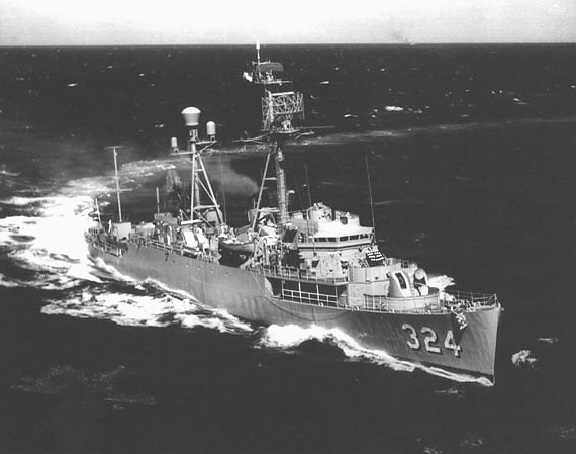
DER-324 (USS Falgout) off Pearl Harbor 30 August 1963
When WW2 ended, not only the USN was found with hundred of regular destroyers, but also hundred of escort destroyers as well. However the latter were made with a single, well defined purpose in mind: Dealing with U-boats in the Atlantic. Whereas many contructions were cancelled in the summer of 1945, extisting ships, barely a few years old, were mothballed in endless NyD parks. However some were left uncompleted and completed in 1950 as DER 31 ships (‘Destroyer Escort Radar’) for several classes and three DEC of the Buckley (TE) class. In 1961 (The Berlin crisis), many were reactivated as there was a new submarine threat: Soviet submarines. The Whiskey class alone claimed about 250 boats, and they were much more capable than WW2 Type VII, they were closer to modernized versions of the Type XXI.
Radar picket ships conversions were indeed developed fromp what was learnt in the Pacific. The Navy still needed an early warning system and the stopgap measure chosen was to convert many of these numerous escorts. After experimenting with several BUCKLEY class DEs, swapping their armament for a powerful radar, the USN concluded they were not satisfactory. But the threat of Soviet nuclear missiles ended with an order for 34 DE types (Edsall class) and two JOHN C. BUTLER class. Their conversion looked like APDs with more radar equipment added, and they were thrown in patrol duties in the Atlantic and Pacific. They were under the authority and control of the Distant Early Warning (DEW) Line.
These Destroyer Escort Radar Picket ships (DERs) were like sea-borne air control stations, constantly on alert for any sign of Soviet missile launch. A typical DER spent a month at sea on average, in severe weather. The DEW Line was obsolete by the 1970s, replaced by satellites and DERs were sent to Vietnam where they could indeed track Viet Cong resupply planes.
FRAM-I/II Converted Destroyers (1960-65)
One of the solutions of the Congress backing down any attempt to built a massive fleet of brand new, fast ASW escorts was to recycle obsolescent WW2 destroyers, still available in large numbers and gradually mothballed by the late 1950s. The first of these programs, called FRAM-I (For “Fleet Rehabilitation And Modernization”) was quite extensive and designed to prolongate the active life of the Gearing-class by at least ten years, into the 1970s, whereas in reality most of the infamous “FRAM cans” saw active service until 1982.
Part of the explanation was the late replacement of existing destroyers by the Spruance class because of the Vietnam war. The conversion was also applied to 12 Allen M. Sumner class DDs as well, and 12 Gearing-class with some variations, known as FRAM-II. The conversion was clearly a conversion to versatile escort ships made for a task force to specialized submarine hunters. This was required to answer the new perile of the growing Soviet submarine fleet.
The alarm bell was driven by Admiral Arleigh Burke in 1957, requiring attention from the Pentagon and Congress over the menace of already existing 300 modern submarines used by the Warsaw Pact. Aware of the same threat, the Royal Navy already launched a similar conversion in the 1950s of WW2 destroyers into twenty-three Type 15 first-rate anti-submarine frigates and ten Type 16 limited conversions. The plan did not included older models like the Benson and Fletchers which for the most part has been already modernized for transfer to various NATO countries.
FRAM-I (1960)

FRAM-I USS Charles H Roan
The conversion and overhaul of 78 of the Gearing-class destroyers (all but four remaining) to keep them active for the larger part of the cold war was a considerable undertaking, yest in theory cheaper than to built large series of replacement ASW vessels such as PC-boats. On existing ships alread converted to DDR and DDE, all equipments were scrapped and the ships underwent a variant of the modernization and were called DDs. The rebuilding was total and concerned all interio equipments, superstructure, electronic systems, radar, sonar, and weaponry, with the notable exception of the twin 5-in turrets which in some case were modernized, and one removed. All the WW-2 era AA artillery was removed in particular as well as the old torpedo tubes banks.
In detail, the sensors adopted were the SQS-23 sonar and SPS-10 surface radar. Armament-wise, the biggest leap forward was the adoption of ASROC, two triple banks of Mark 32 torpedo tubes, and DASH for extended ASW strike. The drone had its own landing pad build at the rear, with a small deckhouse. The ASROC took place where the former TT bank resided, and the two smaller Mk.32 TT banks took place each at the front, in place of the turret N°2.
FRAM-II (1962)

FRAM-II USS Ernest G Small
The FRAM-II program was a reboot of the conversion, targeting the older Sumner-class destroyers. However sixteen Gearing class ended upgraded to this standard as well. outside the usual life-extension refurbishment, a new radar system was installed, new electronics, and new armament, with Mark 32 ASW banks of torpedo tubes, DASH ASW drone, and variable depth sonar but not ASROC.
Six DDRs and six DDEs retained their original configuration in 1960–61 and four DDRs that were converted to DDs in 1962–63. All three 5-inch gun turrets were kept for all but the few ships converted as DDEs which swapped a turret for a trainable Hedgehog. FRAM IIs had two additional Hedgehogs alongside turrets or existing systems. The four converted DDRs had also now long-range 21-inch torpedo tubes, operating the Mark 37 ASW homing torpedo. The ex-DDRs had also two Mk.32 TTs installed alongside the small superstructure built behing the main bridge and funnel, where the ASROC was situated. A the stern, the VDS (Variabke Depth Sonar) was installed. For easier recoignition, the six other DDRs had no DASH landing spot markings and a smaller deckhouse so their use of DASH was limited, if any.
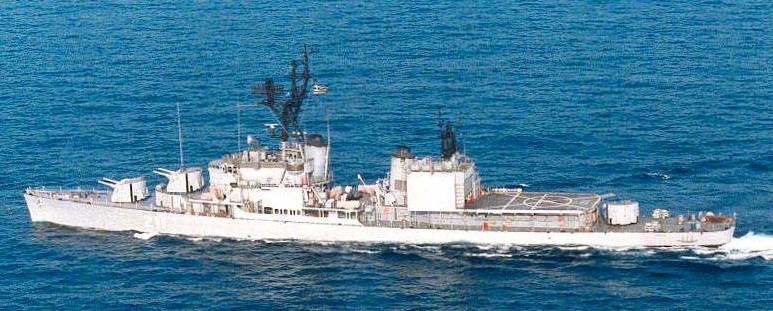
One of the last FRAM II, an Allen M Sumner class further modernized after transfer to Greece, D211 Miaoulis (seaforces.org).
 Dealey class Ocean Escorts (1953)
Dealey class Ocean Escorts (1953)
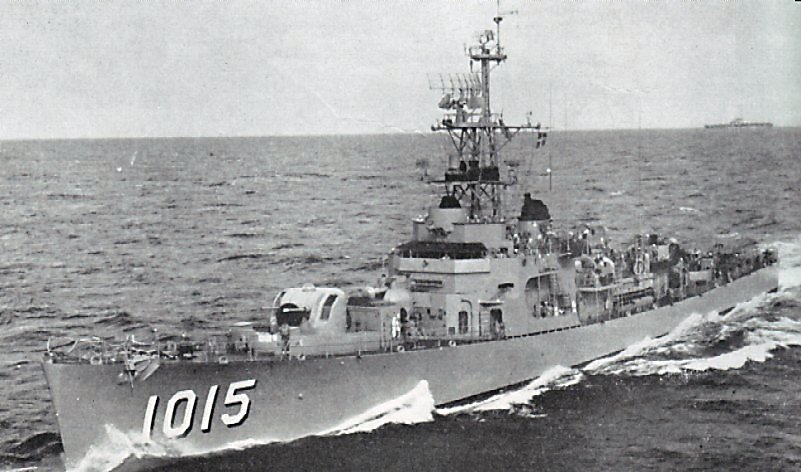
These ships started as enlarged PC-boat or coastal patrol ASW ships, with better armament, range and detection systems. As the world was found in a cold war environment, the design was modified so the ships could be turned into very large mobilization series, and for example had a single propeller and proven, well-tested and cheap equipments and half the crew of a destroyer.
In addition to two twin dual-purpose 3 in guns (76 mm), fore and aft the the ship, the forward one enclosed in a turret, they had a Weapon Alfa ASW system of rocker launcher, while the USS Dealey, first of the serie, possessed a British squid system.
Their electronic gear consisted of a SPS-6 radar and SQS-4 Sonar. Although their geared turbine coupled to two boilers gave them 20,000 hp, enough for achieving 27 knots and a 6000 nautical miles range, they were criticized to be under-armed.
Nevertheless, 13 ships were built, which gave all satisfaction to the USN and the design was also exported to Portugal, and Norway. In 1963 through the FY62 program, three ships (Dealey, Courtney, Cromwell) were given the SQS-23 sonar, DASH spot and hangar, while the remainder received a SQS-4 sonar, and variable depth sonar model and in the late 1960s, Mark 32 triple ASW torpedo banks. They were decommissionned in 1972-73.
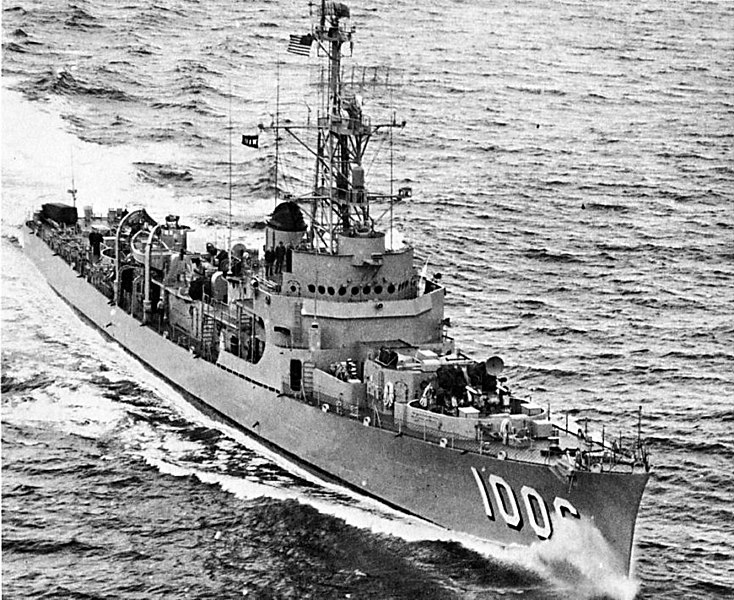

Dealey class blueprint rendition. src: Unknown
Dealey class Characteristics:
Displacement: 1314t standard, 1877t PC
Dimensions: 93.9 pp/96 oa x 11.2 x 3.6m
Propulsion: 1 shaft geared Westinghouse turbine, 2 Foster Wheeler boilers, 20,000 hp. and 27 knots. RA 6000 Nm/12 knots.
Crew: 173
Sensors: SPS-6 40 Radar, SQS 4 sonar.
Weaponry: 4 x 3 in (76 mm), Weapon Alfa (ASWRL), 2x 3 TTs, 2 DCTs.
 Claud Jones class Ocean Escorts (1958)
Claud Jones class Ocean Escorts (1958)
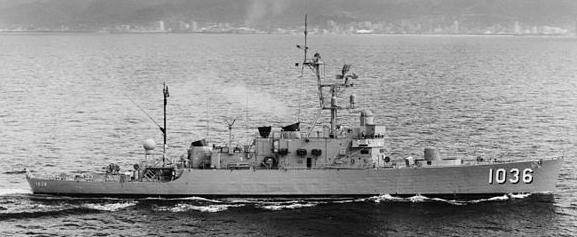
USS McMorris off Oahu in March 1972, two years before being sold. The class was one of the worst ASW ships ever fielded by the USN
The Dealey were considered costly ASW vessels, moreover if compared to the original PC-boats they were supposed to replace. The USN admiralty launched in 1955 already a study for their complement by a cheaper version. As a result, the final ship, which designed was approved in 1957 and first laid down at Avondale in June 1957, was “minimal” in her approach, with just two dual purpose guns and instead of Weapon alfa, two more classic hedgehogs, derived from WW2 models. Their hull was slighly wider and deeper, but a tad shorter also.
In addition two lightweight ASW torpedo tubes were installed, on each side.
There was also a drastic reduction of power, with only 8700 hp produced, enough however for 21 knots. However range was better, 7000 bautical miles covered instead of 6000. The sensors, radar and sonar, were the same. The crew was not significantly reduced. But the end result, in service by 1959, was hatred by crews and officers alike.
There was a backlash in reports inside the admiralty and a new study was launched quickly to create better ships overall, which ended with a leap forward, the Bronstein. In 1961, freshly introduced, USS Charles Berry and McMorris (DE1035-1036) received a Norwegian-designed Terne III Rocket-Launched Depht charge system and even lighter torpedo tubes. Their ASW service was cut short, as they were consirered unsuited for the job, and instead they were converted as electronic reconnaissance ships for the Pacific fleet. In 1974 all four were resold to the Indonesian Navy as Mongidisiri (Claud Jones), Samadikun (John R Perry), Martadinata (Berry), Ngurah Rai (McMorris).
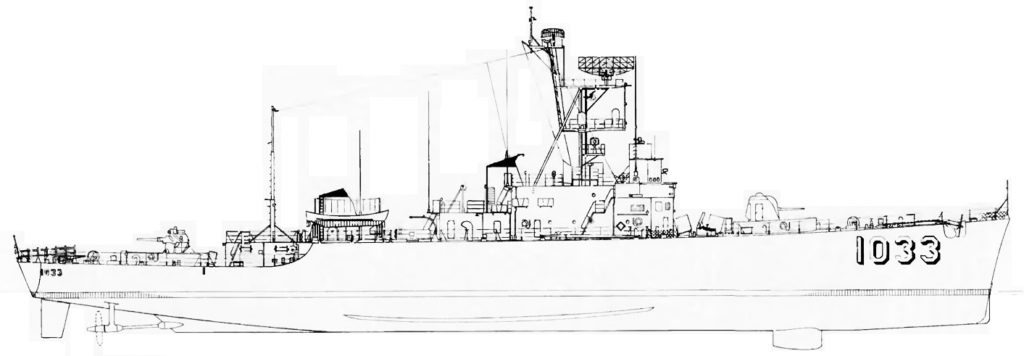
Claud Jones class blueprint rendition. src: Unknown
Claud Jones class Characteristics:
Displacement: 1314t standard, 1916t PC
Dimensions: 91.8 pp/95.1 oa x 11.6 x 3.9m
Propulsion: 2 shaft diesels, 8,700 hp. and 21.5 knots. RA 7000 Nm/12 knots.
Crew: 171
Sensors: SPS-6 Radar, SQS 4 sonar.
Weaponry: 2 x 3 in/50 (76 mm), 2 Hedgehog ASWRL, 2×3 ASW TTs, 1 DCT.
 Bronstein class Ocean Escorts (1962)
Bronstein class Ocean Escorts (1962)
The Bronstein class was designed in reaction to the vivid criticism met by the previous Claud Jones, and were a kind of return to the Dealey approach but with a new SQS 26 Sonar, ASROC and DASH systems which were also brand new. They only kept one of the original 3-in DP twin mounts, the other turret being a single mount. This strange arrangement was also meant to gain in ASW capabilities. There was a loss of speed though, despite a power back to 20,000 hp, at 26 knots (one knot less). Range also was the worst yet at 4000 nm at 15 knots.
As a result, the Bronstein were slower than the ASW task frce in which she was supposed to operate, whereas the limited range was a problem too. Compared the the first Soviet SSNs capable of 30 knots, the ships were not up to the task despite presenting a hull shape, superstructure, armament and electronics up to the task. Only two ships were built as a result, almost an experiment. They were the USS Brontein (DE 1037) and USS McCloy (DE 1038) built at Avondale, laid down in 1961, launched march and june 1962 and completed june and october 1963.
In the 1970s, their aft 3 in gun was removed and a variable depht sonar installed instead. A towed array surveillance sonar was also fitted on both ships at that time, and Bronstein inaugurated the SQS 15 towed array sonar ASW system. Both were often sidelined in operations due to their poor performances but saw the cold war up to the end, being stricken in December 1990.

Profile from blueprints of the Bronstein (Conways)
Bronstein class Characteristics:
Displacement: 1882t standard, 2732t PC
Dimensions: 106.7 pp/113.4 oa x 12.5 x 7.0m
Propulsion: 1 shaft De Laval geared turbine, 2 Foster Wheeler boilers, 20,000 hp. and 26 knots. RA 4000 Nm/15 knots.
Crew: 191
Sensors: SPS-40 Radar, SQS 26 sonar.
Weaponry: 1×2 + 1 in/50 (76 mm), ASROC, DASH, 2x 21 in TTs, 2×3 Mk 32 ASW TTs, 1 DCT.
 Garcia class Ocean Escorts (1963)
Garcia class Ocean Escorts (1963)
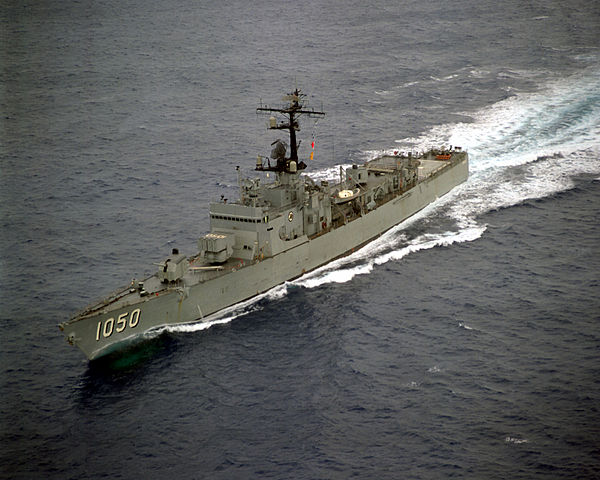
USS Albert David in 1965
Ships: Garcia, Bradley, Ed. Mc Donnell, Brumby, Davidson, Voge, Sample, Koelsch, Albert David, O’Callahan, and Glover (AGDE-1).
With the new generation of Soviet submarines, started with the November class SSN, there was an urge to design faster escorts. The idea of the admiralty was therefore to keep the fundamentals of the previous semi-experimental Bronsteins in terms of armaments and sensors, while giving them a much more powerful set of turbines, able to reach 35,000 hp, for a speed up to 27 knots (at first 30 knots was hoped for). This traduced by a clear cut rise in tonnage. For the same speed, the Garcia were twice the tonnage of the latter.
This time the admiralty took the time to polish the design. First studies emerged in 1959, even before the construction of the Bronsteins, but the first ship, USS Garcia (DE 1040) was not laid down before October 1962, a year and 7 month after. The 17 ships that commprised this class were laid down between 1963 and 1964, launched 1964-66 (Talbot, Page, Furer) and completed in 1964-68 at the Bethlehem (San Francisco), Avondale, Defoe (Bay City), Lockheed (Seattle), and Bath Iron Works shipyards.

Garcia class, USS Voge in 1967. (Conways)
The USS Voge introduced a sloping bulkhead and the new Knox-class ASROC reload magazine. From 1972, all but DE 1048 USS Sample and DE 1050 USS Albert David received a landing pad for a LAMPS Helicopter. Already they received extensive facilities for their DASH drone system. Originally they were fitted with long range torpedoes launched by the stern for Mk24/25 models. This was removed when the program ended, to the benefit of DASH and LAMPS.
Brooke class ships were decommissioned in 1988, some sold to Brazil (Bradley as Pernambuco), Davidson (Paraiba), Sample (Parana), and Albert David (Para), and the others apparently leased to Pakistan, Garcia (Saif), Brumby (Harbah), O’Callahan (Alsat), and Koelsche (Siqqat). The only two not transferred, USS Mc Donnell and Voge, tested variable depht sonars and were stricken in 1992.
About AGDE-1 USS Glover (1965)

USS Glover profile in 1968 (Conways)
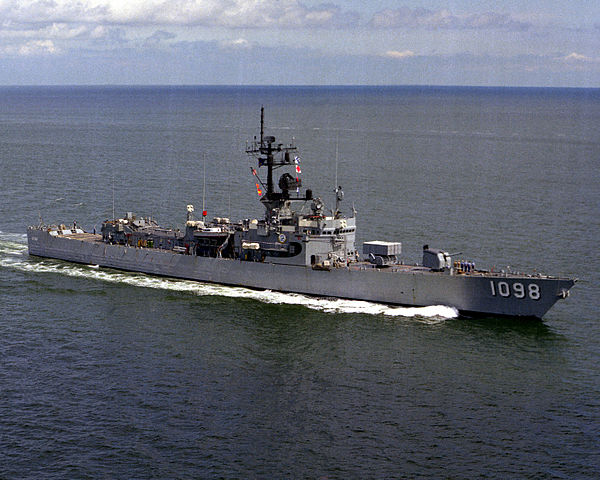
USS Glover had a pumpjet propulsion, raised platform on the rear deck aft, no after 5 in gun, or missile launcher. In 1979 she was redesignated FF 1098, MSC in 1990, deactivated and stricken in 1992.
Garcia class Characteristics 1964:
Displacement: 1882t standard, 2732t PC
Dimensions: 106.7 pp/113.4 oa x 12.5 x 7.0m
Propulsion: 1 shaft Westinghouse geared turbine, 2 Foster Wheeler PF boilers, 35,000 hp. and 27 knots. RA 4000 Nm/20 knots.
Crew: 208
Sensors: SPS-40 Radar, SQS 26 sonar.
Weaponry: 1×2 + 1 in/50 (76 mm), ASROC, DASH, 2x 21 in TTs, 2×3 Mk 32 ASW TTs, 1 DCT.
 Brooke class Ocean Escorts (1965)
Brooke class Ocean Escorts (1965)
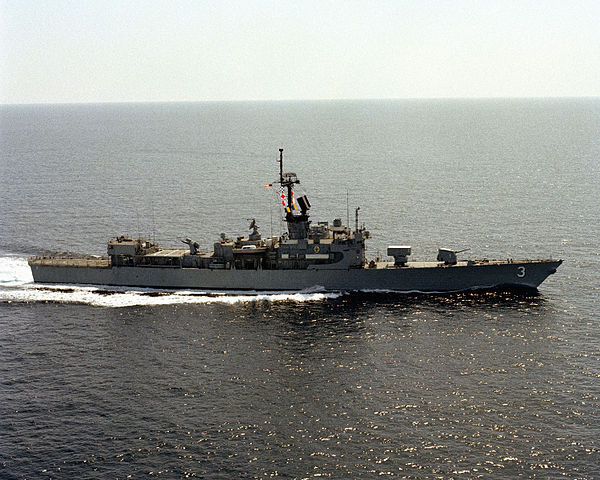
USS Schofield in the 1960s
6 frigates, Numbered DEG-1 to 6 (Brooke, Ramsey, Schofield, Talbot, Richard L Page, Juluis A Furer)
The Brooke class is in reality closer to a sub-class for the Garcia than a true independent class, since both shared most of their components, hull, and engines. But sensors and armaments wise, both ships diverged, to the point the Brooke were denominated FFG and not FF like the Garcia class from 1975.
These were indeed missile versions, whereas the others were ASW versions. The Brooke class had a single 5 in/38 gun, and a Tartar SAM missile, with 16 reloads. The 21-in ASW TTs were removed, and instead of the SPS-40 radar, the Brooke had the SPS-39 and SPG-51 fire control system for the Tartar launcher. They still retained their ASROC as a main ASW weapon system.
All but two ships (Ramsey and Schofield) were apparently leased to Pakistan after decommission in 1988 as Khaibar (Brooke), Hunam (Talbot), Tabuk (Page) and Badr (Richard L Page). There are some confusion as Conway’s source speaks of a decommission in 1988 while the leasing transfer was dated from 1986. All these Frigates were returned to US in 1993–95 when the renewing of lease with an option of purchase was denied by the United States. Today Pakistan operates a single ex-USN Frigate, PNS Alamgir (F-260), of the Perry class. The returned Frigates were replaced by four Ex Royal Navy Type 21 frigates (Tariq class) and joint-constructed Zulfiquar-class with China.

USS Brooke profile in 1969 (Conways)
Brooke class Characteristics 1964:
Displacement: 1882t standard, 2732t PC
Dimensions: 106.7 pp/113.4 oa x 12.5 x 7.0m
Propulsion: 1 shaft Westinghouse geared turbine, 2 Foster Wheeler PF boilers, 35,000 hp. and 27 knots. RA 4000 Nm/20 knots.
Crew: 228
Sensors: SPS-39 Radar, SPG-51 FCS, SQS 26 sonar.
Weaponry: 1 x 1 in/50 (76 mm), Tartar SAM, ASROC, DASH, 2×3 Mk 32 ASW TTs.
 Knox class Ocean Escort (1966)
Knox class Ocean Escort (1966)
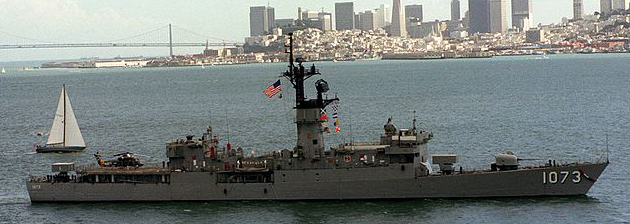
USS Robert E Peary (FF-1073) off San Francisco
The Knox Class Frigates (named after the Secretary of State for the Treasury (1888-1956)) followed those of the Garcia/Brooke Class of 1962. The first, DE-1052, was started in October 1965 and in service in April 1969. They represented a new generation of ocean escorts (escort destroyer) with the emphasis on ASW defense, while being studied to be more economical and more enduring at the same time. The hull was thus lengthened to receive a more conventional engine installation than high-pressure turbines that were no longer favored by the admiralty, and to receive a larger tank space. They were criticised for their limited armament (only a single 127 mm gun, but a modern automated 54 calibres QF, long range) and unique propeller.
Interior roomy fittings and reduced crew gave them a good flexibility and adaptability and a better livability, even comfort. It was planned to install equipment for an AA missile ramp, which was finally abandoned, and tests were carried out with ASW DASH drones. In the end, an eight-foot sea sparrow launcher was fitted behind the runway aft. The bow was enhanced by an important bulwark. Their name DE (destroyer escort) persisted until 1975, officially replaced by FF (Frigate). From the 1970s, Avondale yards, already specialized, was solely responsible for the production of Knox, which totalled 46 units, the last, USS Moinester (DE-1097) being completed in 1974. That was the mass-produced model the admiralty called for since the 1950s.
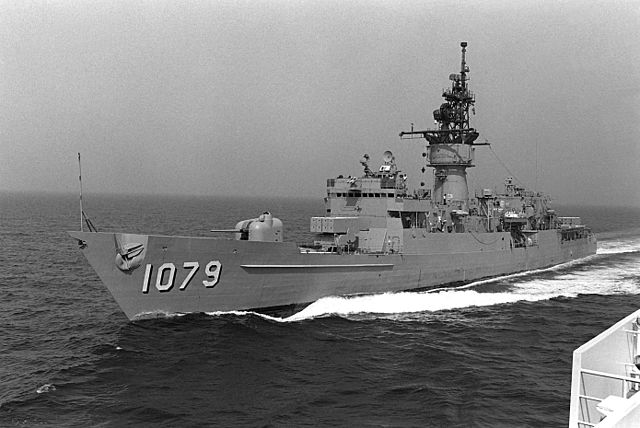
USS Bowen FF-1079
In 1990, the end of the cold war meant retirement for ships between 20 and 30 years old. It was planned to keep eight for the training of naval reservists, but they were eventually put in reserve and deactivated, like the rest of the units in 1991-94. A total of 23 units were transferred to friendly navies, Greece and Turkey in 1992, then Egypt, Taiwan, Thailand. Other countries such as Spain, Morocco or Brazil and Venezuela refused, because of the sad state of their propulsion. A handful of these buildings are still in use today.

USS Knox – Author’s illustration
Characteristics:
Displacement: 3020t standard, 4066t FL
Dimensions: 133.5 x 14.3 x 7.6m
Propulsion: 1 propeller, 1 Westinghouse turbine, 2 boilers, 35,000 hp and 27 knots. RA 4500 MN.
Crew: 224
Sensors: 1 SPS 40 Radar, SQS 26 and SQS 35 sonar.
Weaponry: 1 x 127 mm DP, 1 x 8 sea Sparrow, 1 x 8 ASROC ASW (16 m), 2 x 2 ASW 324 mm TTs (22), 1 LAMPS I helicopter.
 Oliver Hazard Perry class Ocean Escort (1976)
Oliver Hazard Perry class Ocean Escort (1976)
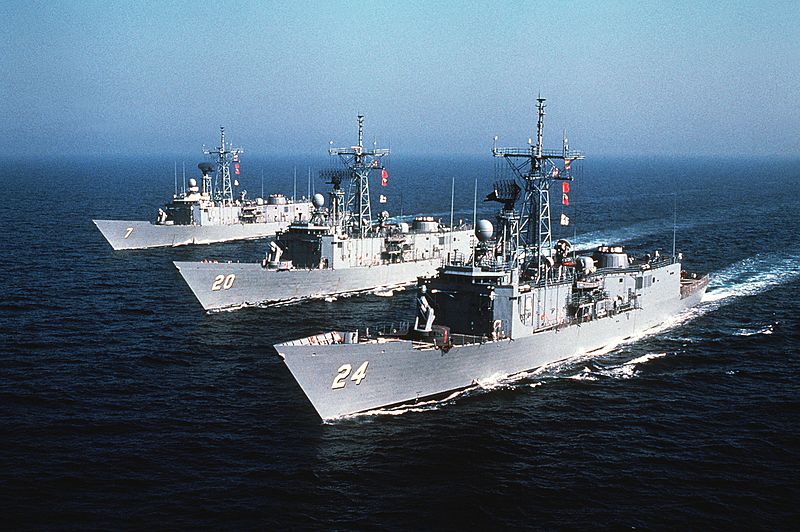
Ten years after the launch of the USS Knox, the US Navy launched the O.H. Perry class. Criticisms concerning the Knox were the same for the Perry, who descended in line, with the same specifications. This time, however, the AA gun had given way to a versatile SAM / harpoon mid-range launcher, the only gun being an ultra-fast, anti-missile capable 76 mm model installed on the superstructure, and later supplemented by a Vulcan-Phalanx CIWS model.
Although the hull was slightly longer than the Knox, the hydrodynamic qualities were reworked and the tonnage was lower with a clear draft, a higher speed and increased autonomy. The superstructures were also enlarged considerably, as was the case with the Spruance, giving them more modularity for future upgrades. The hangar also benefited from this extension and could accommodate two heavier LAMPS III seawahk helicopters or a even a Sea King. Gas turbines had been improved to achieve these objectives and the mack had disappeared, the funneks being relocated on the rear superstructure and shortened, while sensors and radars were setup on two derricks masts, clear from obstruction.
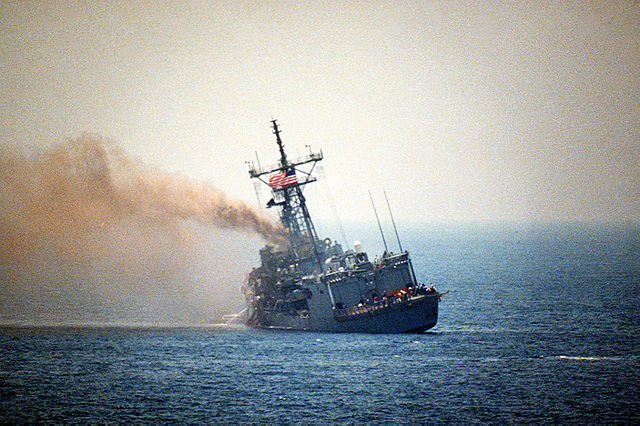
In the Persian Gulf, a port quarter view of the guided missile frigate USS STARK (FFG-31) listing to port after being hit by two Iraqi Exocet missiles within 30 seconds. 37 sailors are killed.
One of the advantages of these ships was the redundancy of their systems, allowing, for example, to compensate for the decommissioning of the main thrusters by a pair of 325cv side thrusters, the short-range bow sonar supplemented by the towed sonar at the stern and two helicopters LAMPS. Admiral Zumwalt was the main proponent of these ships, designing them as smaller, less expensive versions of the Spruance class DDs.
Indeed their front box launcher, buried into the hull had the ability to send a Harpoon for real antiship capabilities, in addition to SAMs also carried in the same modular unit. The loss of the ASMC ASW launcher was largely compensated by the presence of two ASW helicopters. The first ship was in service in November 1979, the last one in August 1989. They were omnipresent during the Gulf War, several being equipped with two AA bushmaster guns and their tonnage had increased significantly with the addition of protective armor of Kevlar alloys. The USS Starck took two exocet missiles in 1987 during the Iran-Irak war and survived, while samuel B roberts hit a mine at the stern and also survived. Several ships were built on modified plans for Australia, Taiwan and Spain. Several transfers were planned in 1994, canceled by Admiral Boorda in 1995: Fleet Presence Requirements froze offers made to Turkey.

Author’s rendition of the O.H. Perry
Characteristics:
Displacement: 2650t standard, 3490t FL
Dimensions: 135.7 x 14.5 x 4.4 m
Propulsion: 1 propeller, 2 gas turbines 2500 GE, 40,000 hp. and 28.5 knots. RA 4500 MN.
Crew: 176
Sensors: 1 SPS 49 radar, 1 CT Mk.92, SQS 56 sonar.
Armament: 1 x 76 mm DP, 1 standard SAM/Harpoon launcher (40 vectors), 2 x 3 ASW 324 mm TTs (24), 2 helicopters LAMPS III.
 2030s Constellation class Frigates
2030s Constellation class Frigates
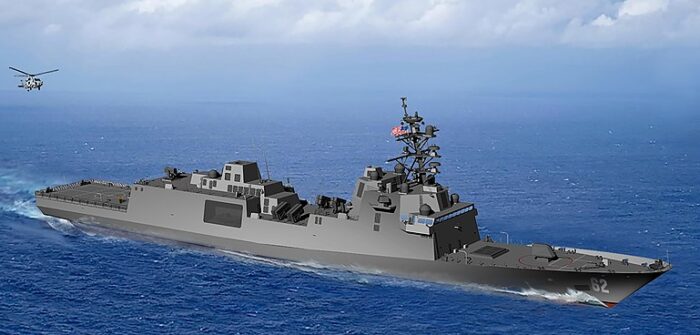
Since the OH Perry ships has been decommissionned from the 1990s to the 2000s (2014 for the last), the US Navy is without any frigate in service since 1943, USS Constitution being a relic. The LCS (Littoral Combat Ships) were equally modular and fast, but they are few in number as production stopped in 2019 after the 20th unit. With Pdt. Trump’s administration objective was of 355 ships, with discussions about reactivating some OH Perry, until a replacement program was drafted.
Many competitor’s designs were studied by the admiralty commission. They needed to be fast, stealthy, highly modular with heavy automation for a reduced crew and updated AEGIS capabilities. The FFG(X) was set for 2020, a short time which left only the possibility of adapting an existing “parent” design. Construction started in 2024.
Update 2024: Now known as the Constellaiton class and based on the Italian FREMM design, rhz program is ongoing with the first delivery expected in 2026. However the program had fallen into much controversy due to design massive changes (negating the use of an existing design in the first place), design shortcomings, construction delays at Fincantieri US leading to a Congress audition.
The need is urgent given a degrading situation developing in the China sea and the class which is supposed to complement the Arleigh Buke on less important theaters and show the flag while keeping important all-around capabilities is probably now delayed until 2030-38 at best.
Read More/Src
designation-systems.net 7-inch
navweaps.com – WAMUS ASW
destroyerhistory.org/coldwar/worldwariiclasses/
alternatewars.com – SQS_Series
Fleet_Rehabilitation_and_Modernization
ussslater.org history modifications
destroyerhistory.org cold war escorts
navsource.org archives
gyrodynehelicopters.com
thedrive.com: navys future frigates: more lethal and capable as well as cheaper
web.archive.or – bronstein class

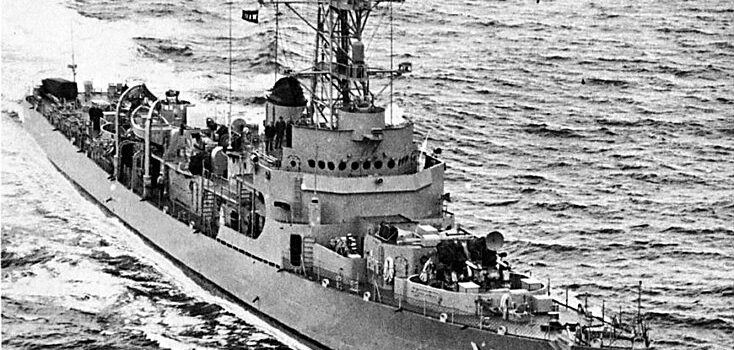

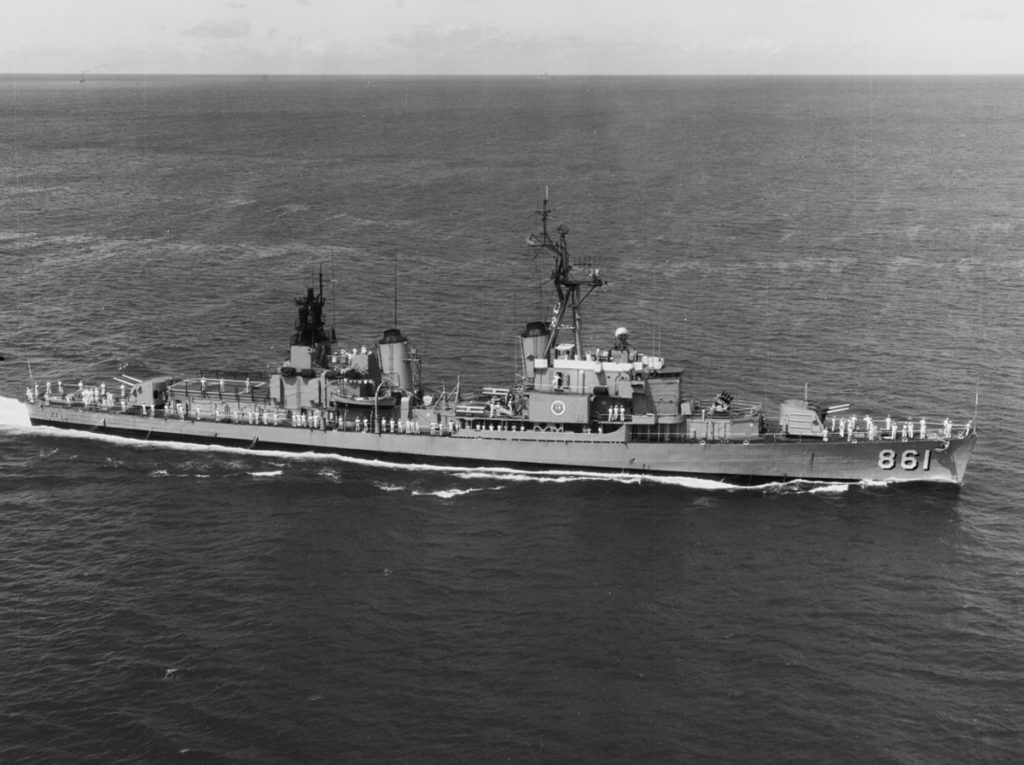
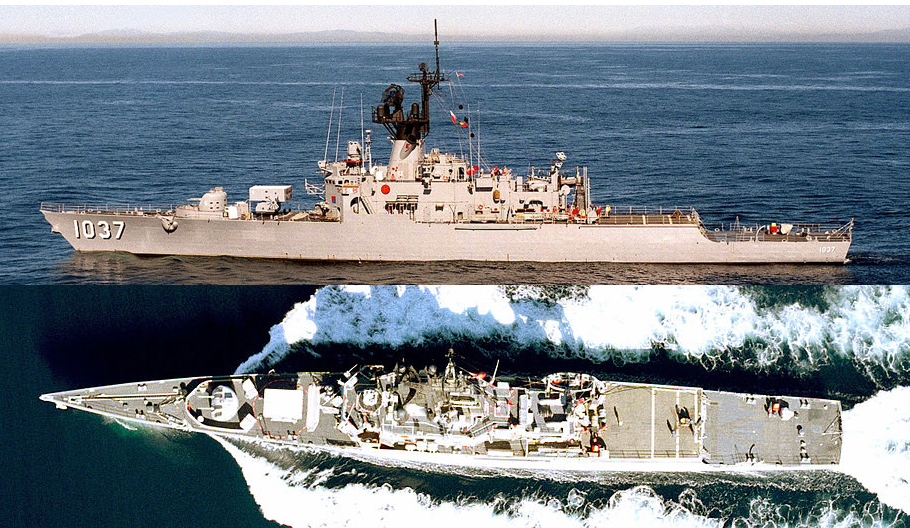
 Latest Facebook Entry -
Latest Facebook Entry -  X(Tweeter) Naval Encyclopedia's deck archive
X(Tweeter) Naval Encyclopedia's deck archive Instagram (@navalencyc)
Instagram (@navalencyc)





 French Navy
French Navy Royal Navy
Royal Navy Russian Navy
Russian Navy Armada Espanola
Armada Espanola Austrian Navy
Austrian Navy K.u.K. Kriegsmarine
K.u.K. Kriegsmarine Dansk Marine
Dansk Marine Nautiko Hellenon
Nautiko Hellenon Koninklije Marine 1870
Koninklije Marine 1870 Marinha do Brasil
Marinha do Brasil Osmanlı Donanması
Osmanlı Donanması Marina Do Peru
Marina Do Peru Marinha do Portugal
Marinha do Portugal Regia Marina 1870
Regia Marina 1870 Nihhon Kaigun 1870
Nihhon Kaigun 1870 Preußische Marine 1870
Preußische Marine 1870 Russkiy Flot 1870
Russkiy Flot 1870 Svenska marinen
Svenska marinen Søværnet
Søværnet Union Navy
Union Navy Confederate Navy
Confederate Navy Armada de Argentina
Armada de Argentina Imperial Chinese Navy
Imperial Chinese Navy Marinha do Portugal
Marinha do Portugal Mexico
Mexico Kaiserliche Marine
Kaiserliche Marine 1898 US Navy
1898 US Navy Sovietskiy Flot
Sovietskiy Flot Royal Canadian Navy
Royal Canadian Navy Royal Australian Navy
Royal Australian Navy RNZN Fleet
RNZN Fleet Chinese Navy 1937
Chinese Navy 1937 Kriegsmarine
Kriegsmarine Chilean Navy
Chilean Navy Danish Navy
Danish Navy Finnish Navy
Finnish Navy Hellenic Navy
Hellenic Navy Polish Navy
Polish Navy Romanian Navy
Romanian Navy Turkish Navy
Turkish Navy Royal Yugoslav Navy
Royal Yugoslav Navy Royal Thai Navy
Royal Thai Navy Minor Navies
Minor Navies Albania
Albania Austria
Austria Belgium
Belgium Columbia
Columbia Costa Rica
Costa Rica Cuba
Cuba Czechoslovakia
Czechoslovakia Dominican Republic
Dominican Republic Haiti
Haiti Hungary
Hungary Honduras
Honduras Estonia
Estonia Iceland
Iceland Eire
Eire Equador
Equador Iran
Iran Iraq
Iraq Latvia
Latvia Liberia
Liberia Lithuania
Lithuania Mandchukuo
Mandchukuo Morocco
Morocco Nicaragua
Nicaragua Persia
Persia San Salvador
San Salvador Sarawak
Sarawak Uruguay
Uruguay Venezuela
Venezuela Zanzibar
Zanzibar Warsaw Pact Navies
Warsaw Pact Navies Bulgaria
Bulgaria Hungary
Hungary

 Bundesmarine
Bundesmarine Dutch Navy
Dutch Navy Hellenic Navy
Hellenic Navy Marina Militare
Marina Militare Yugoslav Navy
Yugoslav Navy Chinese Navy
Chinese Navy Indian Navy
Indian Navy Indonesian Navy
Indonesian Navy JMSDF
JMSDF North Korean Navy
North Korean Navy Pakistani Navy
Pakistani Navy Philippines Navy
Philippines Navy ROKN
ROKN Rep. of Singapore Navy
Rep. of Singapore Navy Taiwanese Navy
Taiwanese Navy IDF Navy
IDF Navy Saudi Navy
Saudi Navy Royal New Zealand Navy
Royal New Zealand Navy Egyptian Navy
Egyptian Navy South African Navy
South African Navy






























 Ukrainian Navy
Ukrainian Navy dbodesign
dbodesign
Very nice write. But, although the Perry Class is named after Oliver Hazard Perry, it was Matthew Perry who negotiated the opening of Japan to trade with the United States and the rest of the Western World. They were brothers though.
Hello Alex
Thanks to notice, the old translated text needed some proofreading, now it’s done !
Best,